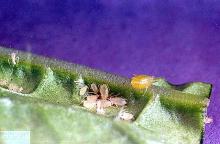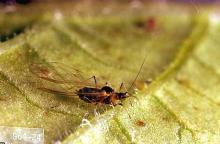Includes
Cabbage aphid (Brevicoryne brassicae)
Green peach aphid (Myzus persicae)
Turnip aphid (Hyadaphis pseudobrassicae)
Pest description and crop damage The cabbage aphid is gray-green with a waxy bloom. It forms dense colonies that cannot be removed before processing or marketing. The turnip aphid looks very much like the cabbage aphid but lacks the waxy bloom. It tends to be more evenly distributed over plants. The green peach aphid is slender, dark green to yellow, and has no waxy bloom. It is primarily an early year pest. Green peach aphid infestations may result in wilting.
Biology and life history
See:
Common Pests of Vegetable Crops
Pest monitoring Check fields frequently after seedling emergence. If aphids become numerous, increase frequency of sampling. Aphids often are concentrated in hot spots or near the field margin. Note the presence of any hot spots, but avoid sampling only those areas. Also, be sure to look for evidence of biological control; i.e., the presence of predators, parasitoids (aphid mummies), and pathogens. Aphid flights are most common during periods of moderate temperatures (60° to 80°F). Monitor fields particularly closely during April and May.
Management-biological control
Many parasitoids and predators attack aphids. Early year aphids have many natural enemies that frequently bring them under control later in the year. Among the more common predators are lady beetles and their larvae, lacewing larvae, and syrphid fly larvae. Populations of green peach aphids are reduced in winter by the insect pathogenic fungus Entomophthora aphidis.
Monitor the proportion of aphid mummies relative to unparasitized aphids and the numbers of predators such as lady beetles. If the proportion of mummies is increasing, or predators appear to be gaining control, and aphid populations are not yet damaging, avoid sprays that will disrupt these natural enemies if the crop is not entering a susceptible stage. Most materials available for aphid control are highly disruptive of natural enemy populations.
Management-cultural control
Destroy infested crops immediately after harvest to prevent dispersal. Destroying weed hosts late in the year may help destroy overwintering populations. Aphid populations tend to be higher in crops that are fertilized liberally with nitrogen. Roguing diseased plants early may help slow the spread of aphid-vectored diseases.
Home gardeners can often get effective control by washing aphids with a strong stream of water.
Management-chemical control: HOME USE
- acetamiprid
- azadirachtin (neem oil)-Some formulations are OMRI-listed for organic use.
- bifenthrin (as a mix with zeta-cypermethrin)-Not registered for home use on celery in WA.
- capsaicin-Some formulations are OMRI-listed for organic use.
- carbaryl
- cyfluthrin
- esfenvalerate-Do not use on kale.
- horticultural oil-Some formulations are OMRI-listed for organic use.
- imidacloprid
- insecticidal soap-May require several applications. Some formulations are OMRI-listed for organic use.
- kaolin-Applied as a spray to foliage it acts as a repellent to some insect pests. Some formulations are OMRI-listed for organic use. Do not use on kale. Not registered for use in OR.
- malathion
- permethrin
- plant-derived essential oils (rosemary, peppermint etc.)-These have some efficacy against aphids. Some formulations are OMRI-listed for organic use.
- pyrethrins-Some formulations are OMRI-listed for organic use.
- zeta-cypermethrin
Management-chemical control: COMMERCIAL USE
- acetamiprid (Assail 30SG) at 0.038 to 0.1 lb ai/A. PHI 3 days. REI 12 hr. Do not exceed 0.375 lb ai/A per year or 4 applications per season. Retreatment interval 7 days.
- alpha-cypermethrin (Fastac EC) at 0.02 to 0.025 lb ai/A. PHI 1 day. REI 12 hr. Retreatment interval 7 days. Do not exceed 0.075 lb ai/A per season.
- azadirachtin (Neemix 4.5-B) at 0.018 to 0.049 lb ai/A. PHI 0 days. REI 4 hr. OMRI-listed for organic use. Not registered for use in OR.
- Beauveria bassiana (Mycotrol ESO) at 0.25 to 1 quart/A. PHI 0 days. REI 4 hr. OMRI-listed for organic use.
- beta-cyfluthrin/imidacloprid (Leverage 360) at 0.07 lb ai/A. PHI 7 days. REI 12 hr. Retreatment interval 7 days. Do not exceed 0.1 lb ai/A beta-cyfluthrin or 0.2 lb ai/A imidacloprid per season.
- bifenthrin (Brigade 2EC, Sniper) at 0.033 to 0.1 lb ai/A. PHI 7 days. REI 12 hr. Retreatment interval 7 days. Do not exceed 0.4 lb ai/A per season.
- bifenthrin/imidacloprid (Brigadier) at 0.06 to 0.095 lb ai/A. PHI 7 days. REI 12 hr. Do not exceed 0.24 lb ai/A imidacloprid and 0.24 lb ai/A bifenthrin. Retreatment interval 7 days.
- bifenthrin/zeta-cypermethrin (Hero EW) at 0.04 to 0.1 lb ai/A. PHI 7 days. REI 12 hr. Retreatment interval 7 days. Do not exceed 0.45 lb ai/A per season.
- borate complex (Prev-Am Ultra) applied as a 0.8% solution. Spray to complete coverage. REI 24 hr. Retreatment interval 7 days. OMRI-listed for organic use.
- Burkholderia spp. (Venerate XC) at 2 to 4 quarts/A product. PHI 0 days. REI 4 hr. OMRI-listed for organic use.
- Chenopodium ambrosioides extract (Requiem Prime) at 4 to 8 pints formulated product per acre. REI 4 hr. Limit 10 applications. Use high rate when conditions are favorable for heavy pressure.
- chlorantraniliprole/thiamethoxam (Voliam Flexi) at 0.1 to 0.175 lb ai/A. PHI 7 days. REI 12 hr. Retreatment interval 7 days. Do not exceed 0.172 lb ai of thiamethoxam or 0.2 lb ai of chlorantraniliprole per acre per growing season.
- clothianidin (Belay) at 0.05 to 0.067 lb ai/A foliar, 0.15 to 0.2 lb ai/A soil. PHI 7 days foliar, 21 days soil. REI 12 hr. Retreatment interval 10 days. Do not exceed 0.2 lb ai/A per season.
- Chromobacterium subtsugae (Grandevo) at 0.6 to 0.9 lb ai/A per 100 gal. PHI 0 days. REI 4 hr. OMRI-listed for organic use.
- cyantraniliprole (Exirel) at 0.088 to 0.133 lb ai/A. PHI 1 day. REI 12 hr. Retreatment interval 5 days. Limit 6 treatments per year. Do not exceed 0.4 lb ai/A per year.
- dimethoate (Dimethoate 4EC, Dimethoate LV-4) at 0.25 lb ai/A. PHI 14 days. REI 48 hr. Do not exceed 1.5 lb ai/A per season. Retreatment interval 15 days. Kale only.
- dinotefuran (Venom) at 0.088 to 0.131 lb ai/A. PHI 1 day. REI 12 hr. Do not exceed 0.263 lb ai/A per season. Retreatment interval 7 days. Limit 3 treatments.
- flonicamid (Beleaf 50SG) at 0.062 to 0.089 lb ai/A. PHI 0 days. REI 12 hr. Do not exceed 0.267 lb ai/A per season. Limit 3 applications. Retreatment interval 7 days.
- flupyradifuron (Sivanto 200 SL) at 0.09 to 0.16 lb ai/A. PHI 1 day. REI 4 hr. Retreatment interval 7 days. Do not exceed 0.365 lb ai/A per season.
- imidacloprid (Admire Pro) at 0.16 to 0.38 lb ai/A soil and 0.047 lb ai/A foliar. PHI 21 days soil; 7 days foliar. REI 12 hr. Foliar retreatment interval 5 days. Do not exceed 0.38 lb ai/A soil or 0.23 lb ai/A foliar per year.
- imidacloprid (Prey 1.6) at 0.0475 lb ai/A. PHI 7 days. REI 12 hr. Retreatment interval 5 days. Do not exceed 0.23 lb ai/A per year.
- insecticidal soap (M-Pede) at 1 to 2% solution. Potassium salts of fatty acids. See label for gal/A. PHI 0 days. REI 12 hr.
- malathion (Malathion 5) at 1 lb ai/A. PHI 7 days. REI 12 hr. Retreatment interval kale 5 days, collards 7 days. Limit 3 applications.
- naled (Dibrom 8E) at 0.94 lb ai/A. PHI 1 day. REI 48 hr. Retreatment interval 7 days. Limit 5 treatments per season. Do not exceed 9.4 lb ai/A per season.
- pyrifluquinazon (PQZ Insecticide) at 0.035 to 0.047 lb ai/A. PHI 1 day. REI 12 hr. Limit 6 treatments. Retreatment interval 7 days. Do not exceed 0.21 lb ai/A per year. Apply by ground equipment.
- pymetrozine (Fulfull) at 0.086 lb ai/A. PHI 7 days. REI 12 hr. Do not exceed 0.172 lb ai/A per season. Retreatment interval 7 days.
- spirotetramat (Movento) at 0.06 to 0.08 lb ai/A. PHI 1 day. REI 24 hr. Retreatment interval 7 days. Do not exceed 0.16 lb ai/A per crop season.
- thiamethoxam (Actara) at 0.023 to 0.047 lb ai/A. PHI 7 days. REI 12 hr. Retreatment interval 7 days. Do not exceed 0.172 lb ai/A per season.
- thiamethoxam (Platinum) at 0.078 to 0.172 lb ai/A. PHI 30 days. REI 12 hr. Do not exceed 0.172 lb ai/A per season. Apply to the soil as in-furrow spray, band application, drench, shanked or with irrigation.
- thiamethoxam/chlorantraniliprole (Durivo) at 0.195 to 0.257 lb ai/A. PHI 30 days. REI 12 hr. Do not exceed 0.172 lb ai of thiamethoxam or 0.2 lb ai of chlorantraniliprole per acre per growing season.
- tolfenpyrad (Torac) at 0.17 to 0.21 lb ai/A. PHI 1 day. REI 12 hr. Retreatment interval 14 days. Limit 4 treatments per year. Do not exceed 0.42 lb ai/A per year.





